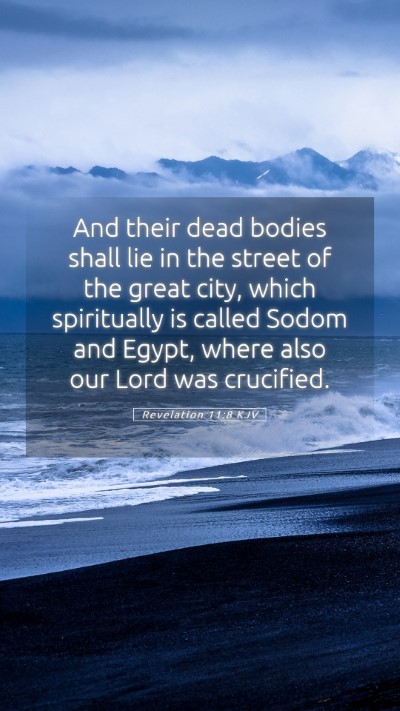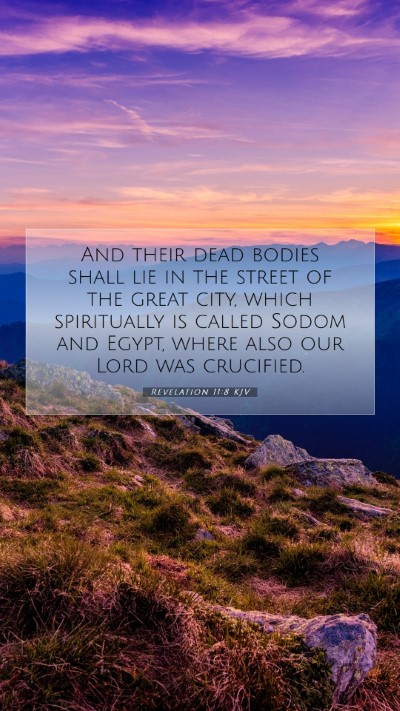Understanding Revelation 11:8
Revelation 11:8 reads, "And their dead bodies shall lie in the street of the great city, which spiritually is called Sodom and Egypt, where also our Lord was crucified." This verse is rich with meaning and invites various interpretations within the broader context of Scripture.
Overview
This passage comes from the prophetic book of Revelation, authored by John. It reflects on the fate of the Two Witnesses—a critical juncture in the apocalyptic narrative that highlights the conflict between divine revelation and human rejection. The imagery of a city called Sodom and Egypt signifies moral degradation and oppression against God's people.
Commentary Insights
-
Matthew Henry's Commentary:
Matthew Henry emphasizes the symbolic nature of the 'great city', identified with Sodom and Egypt, representing a society in rebellion against God. He notes that these cities were notorious for their wickedness and spiritual corruption. The juxtaposition of the bodies lying in the street against the backdrop of Jerusalem, where Christ was crucified, further underscores the spiritual desolation of the people.
-
Albert Barnes' Notes:
Barnes provides a historical context, pointing out that 'the great city' likely refers to Jerusalem itself. He highlights the significance of the Two Witnesses' martyrdom as a testament to their powerful ministry and the tragic hostility from the world. The reference to the 'street' conveys a sense of public disgrace and humiliation for those who stand against God’s truth.
-
Adam Clarke's Commentary:
Clarke expounds on the allegorical connection to Sodom and Egypt. He states that this metaphorical language illustrates the depth of rebellion found in those who reject the gospel. The mention of Christ's crucifixion connects the opposition faced by the witnesses to the world’s longstanding enmity toward divine truth and righteousness.
Analysis and Themes
The verse encapsulates several key themes:
- The Reality of Martyrdom: The dead bodies symbolize the price of faithfulness in a hostile world. This serves as a stark reminder of the consequences faced by those who proclaim God's word.
- Spiritual Significance of Cities: By referring to Jerusalem as Sodom and Egypt, the passage critiques not only the moral decay but also the prevailing idolatry that leads to divine judgment.
- Hope Amid Judgment: Though pertaining to a grim reality, this verse ultimately points toward God's reassurance that justice will prevail, signaling restoration for the faithful.
Application
Understanding this verse in your personal Bible study can lead to profound insights on standing firm in faith amidst persecution and testing. Its historical context provokes reflection on the church's own struggles against cultural condemnation and spiritual complacency.
Cross References
- Revelation 6:9-11: Martyrs cry for justice, paralleling the themes of suffering and vindication.
- Matthew 23:37-39: Jesus laments over Jerusalem, providing a poignant backdrop to the imagery of spiritual ruin.
- Genesis 19:24: The destruction of Sodom underscores the destiny of cities opposed to God.
Conclusion
Revelation 11:8 offers a profound commentary on rebellion against God and its consequences. By engaging in comprehensive biblical exegesis and utilizing various Bible study tools, believers can deepen their understanding and application of Scripture, ultimately enriching their spiritual journey.


